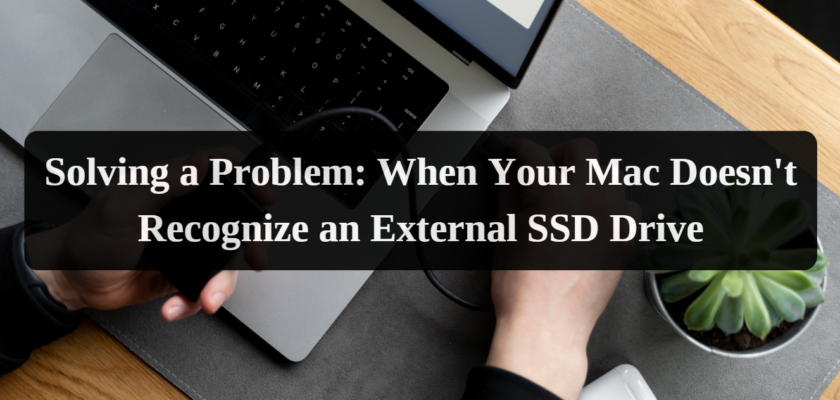Apple Mac users sometimes face an unpleasant problem: their Mac fails to recognize an external SSD. This problem can be disruptive and frustrating, especially for those relying on external drives for storage or backups. This article delves into the problem, exploring its causes and providing a thorough guide to troubleshooting and resolving the issue.
Understanding the Problem
The problem of a Mac not recognizing an SSD can stem from various sources. It’s essential to understand these potential causes to effectively address the issue:
- Physical Connection Issues: Problems with the SSD’s physical connection to the Mac, including issues with cables or ports.
- Initialization and Formatting: New SSDs might not be initialized or formatted correctly, making them invisible to macOS.
- File System Incompatibility: The SSD’s file system might be incompatible with macOS, leading to non-recognition.
- Corruption and Damage: The SSD can become corrupted or physically damaged, making it unreadable.
- Software and Firmware Issues: Outdated or missing software and firmware can prevent the SSD from being recognized.
Solutions
Solution 1: Checking the Connection
Start by checking the SSD’s physical connection. This includes inspecting the cable and port for damage, ensuring the SSD is properly plugged in, and confirming the compatibility of any adapters or enclosures used. A faulty cable or an incompatible adapter can easily cause recognition issues. Swapping cables or trying different ports can often quickly resolve these problems.
Solution 2: Using Disk Utility
Disk Utility is a robust tool within macOS designed for managing and repairing storage devices. When an external SSD is not recognized by your Mac, Disk Utility often provides the necessary tools to diagnose and potentially solve the problem. Here’s a detailed guide on how to use Disk Utility for this purpose:
- Accessing Disk Utility:
- Go to Finder and select “Applications” from the sidebar.
- Scroll down to “Utilities” and open “Disk Utility”. Alternatively, you can use Spotlight (Cmd + Space) to search for “Disk Utility”.
- Locating Your SSD:
- Once Disk Utility is open, look at the left-hand sidebar, which lists all detected storage devices.
- If your SSD is connected but not recognized properly, it should still appear here, possibly grayed out or labeled differently.
- Mounting the SSD:
- If the SSD appears but is not mounted (i.e., not accessible in Finder), select it in Disk Utility.
- Look for the “Mount” button in the top toolbar of Disk Utility. Click it to attempt to mount the SSD. If the drive is healthy, it should now appear on your desktop or in Finder.
- Running First Aid:
- If the SSD is visible but experiencing issues, or if it’s unmountable, use Disk Utility’s First Aid tool.
- Select the SSD from the sidebar and then click on the “First Aid” button in the top toolbar.
- Click “Run” in the dialog box to start the repair process. First Aid will check the disk for errors and attempt to repair any it finds.
- Understanding First Aid Results:
- Once First Aid completes, it will provide a report. If it says that the disk is okay, the SSD should be in good condition.
- If First Aid reports that it can’t repair the disk, this indicates a more serious issue, possibly requiring professional repair or data recovery.
Solution 3: Reformatting the data
If the SSD is still not recognized, it may be necessary to reformat it. However, reformatting will erase all data on the drive. Before proceeding, use data recovery software to retrieve important files. After recovering your data, use Disk Utility to reformat the SSD, which can resolve many recognition issues.
- Using Disk Utility for Reformatting: Open Disk Utility on your Mac. You can find it under Applications > Utilities. Select your SSD from the sidebar in Disk Utility.
- Choosing the Right Format: Click the “Erase” button in Disk Utility. Select the desired format for your SSD. For most Mac users, “APFS” (Apple File System) is recommended, especially for SSDs. If you plan to use the SSD with other operating systems like Windows, choose “ExFAT”.
- Erasing and Reformatting: After selecting the format, click “Erase”. This will delete all content on the SSD and format it to the new file system. Wait for the process to complete. This usually takes only a few minutes, but it can vary based on the SSD’s size.
- Final Checks: Once the reformatting is complete, the SSD should now be recognizable by your Mac. You can close Disk Utility and access the SSD through the Finder.
Solution 4: Checking SSD Health and Compatibility
Ensure that the SSD is not physically damaged and is compatible with your Mac. This might involve checking the health of the SSD using third-party tools or confirming that the SSD’s specifications match your Mac’s requirements. Incompatibilities or failing health can often be the root cause of recognition issues.
Solution 5: Updating Software and Firmware
Outdated software or firmware can prevent an SSD from being recognized. Ensure that your Mac’s operating system is up to date. For certain SSD models, especially those from specific manufacturers like Samsung, installing the latest firmware or dedicated software can be crucial for compatibility.
Solution 6: Seeking Professional Help
If none of the above solutions work, it may be necessary to consult with a professional technician. They can provide more in-depth analysis and potentially repair hardware issues that are beyond the scope of home troubleshooting.
Conclusion
The issue of a Mac not recognizing an SSD can be daunting, but it’s often resolvable with the right approach. Starting with simple solutions like checking connections and restarting your Mac can resolve many issues quickly. More complex problems may require the use of Disk Utility, reformatting, or professional assistance. Understanding the root cause is key to finding the right solution.

